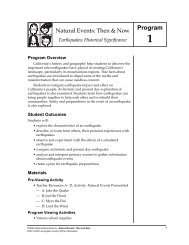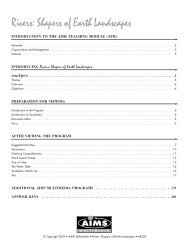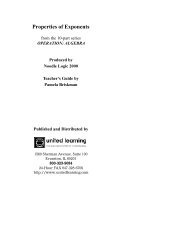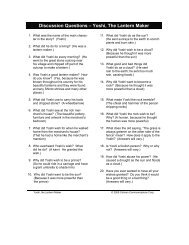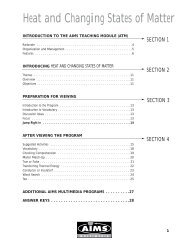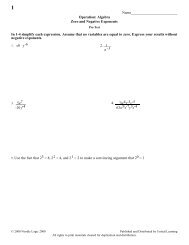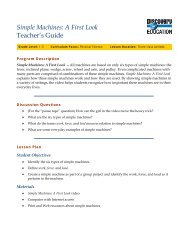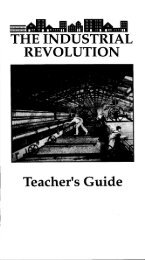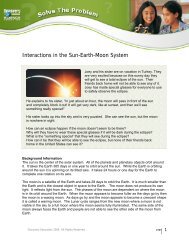Journey to Freedom: The Immigrant Experience
Journey to Freedom: The Immigrant Experience
Journey to Freedom: The Immigrant Experience
You also want an ePaper? Increase the reach of your titles
YUMPU automatically turns print PDFs into web optimized ePapers that Google loves.
<strong>Journey</strong> <strong>to</strong> <strong>Freedom</strong>: <strong>The</strong> <strong>Immigrant</strong> <strong>Experience</strong>INTRODUCTION TO THE AIMS TEACHING MODULE (ATM)Rationale . . . . . . . . . . . . . . . . . . . . . . . . . . . . . . . . . . . . . . . . . . . . . . . . . . . . . .4Organization and Management . . . . . . . . . . . . . . . . . . . . . . . . . . . . . . . . . . . . .5Features . . . . . . . . . . . . . . . . . . . . . . . . . . . . . . . . . . . . . . . . . . . . . . . . . . . . . . .6SECTION 1INTRODUCING JOURNEY TO FREEDOM: THE IMMIGRANT EXPERIENCE<strong>The</strong>mes . . . . . . . . . . . . . . . . . . . . . . . . . . . . . . . . . . . . . . . . . . . . . . . . . . . . . .11Overview . . . . . . . . . . . . . . . . . . . . . . . . . . . . . . . . . . . . . . . . . . . . . . . . . . . . .11Objectives . . . . . . . . . . . . . . . . . . . . . . . . . . . . . . . . . . . . . . . . . . . . . . . . . . . .11SECTION 2PREPARATION FOR VIEWINGIntroduction <strong>to</strong> the Program . . . . . . . . . . . . . . . . . . . . . . . . . . . . . . . . . . . . . . . .13Introduction <strong>to</strong> Vocabulary . . . . . . . . . . . . . . . . . . . . . . . . . . . . . . . . . . . . . . . .13Discussion Ideas . . . . . . . . . . . . . . . . . . . . . . . . . . . . . . . . . . . . . . . . . . . . . . . .13Focus . . . . . . . . . . . . . . . . . . . . . . . . . . . . . . . . . . . . . . . . . . . . . . . . . . . . . . . .13Jump Right In . . . . . . . . . . . . . . . . . . . . . . . . . . . . . . . . . . . . . . . . . . . . . . . . . .14SECTION 3AFTER VIEWING THE PROGRAMSuggested Activities . . . . . . . . . . . . . . . . . . . . . . . . . . . . . . . . . . . . . . . . . . . . .15Vocabulary . . . . . . . . . . . . . . . . . . . . . . . . . . . . . . . . . . . . . . . . . . . . . . . . . . .18Checking Comprehension . . . . . . . . . . . . . . . . . . . . . . . . . . . . . . . . . . . . . . . . .19Immigration Timeline . . . . . . . . . . . . . . . . . . . . . . . . . . . . . . . . . . . . . . . . . . . . .20Natural Disasters . . . . . . . . . . . . . . . . . . . . . . . . . . . . . . . . . . . . . . . . . . . . . . .21Critical Thinking: Chinese Exclusion Act . . . . . . . . . . . . . . . . . . . . . . . . . . . . . . .22Packet Ships Versus Steamships . . . . . . . . . . . . . . . . . . . . . . . . . . . . . . . . . . . . .23Critical Thinking: Immigration Policy . . . . . . . . . . . . . . . . . . . . . . . . . . . . . . . . .24Checking Vocabulary . . . . . . . . . . . . . . . . . . . . . . . . . . . . . . . . . . . . . . . . . . . .25Test . . . . . . . . . . . . . . . . . . . . . . . . . . . . . . . . . . . . . . . . . . . . . . . . . . . . . . . . .26SECTION 4ADDITIONAL AIMS MULTIMEDIA PROGRAMS . . . . . . . . . .28ANSWER KEYS . . . . . . . . . . . . . . . . . . . . . . . . . . . . . . . . .291
© Copyright 1998 AIMS MultimediaAll Rights Reserved. No part of this work may be reproduced or transmitted without written permission of AIMSMultimedia with these exceptions: Persons or schools purchasing this AIMS Teaching Module may reproduceconsumable ATM pages, identified in Section 4, for student or classroom use.AIMS Multimedia is a leading producer and distribu<strong>to</strong>r of educational programs serving schools and libraries fornearly 40 years. AIMS draws upon the most up-<strong>to</strong>-date knowledge, existing and emerging technologies, and all ofthe instructional and pedagogical resources available <strong>to</strong> develop and distribute educational programsin film, videocassette, laserdisc, CD-ROM and CD-i formats.Persons or schools interested in obtaining additional copies of this AIMS Teaching Module, please contact:AIMS Multimedia1-800-FOR-AIMS1-800-367-24672© Copyright 1998 AIMS Multimedia
Congratulations!You have chosen a learning programthat will actively motivate your studentsAND provide you with easily accessibleand easily manageable instructionalguidelines designed <strong>to</strong> make yourteaching role efficient and rewarding.<strong>The</strong> AIMS Teaching Module providesyou with a video program keyed <strong>to</strong> yourclassroom curriculum, instructions andguidelines for use, plus a comprehensiveteaching program containing awide range of activities and ideas forinteraction between all content areas.Our authors, educa<strong>to</strong>rs, and consultantshave written and reviewed the AIMSTeaching Modules <strong>to</strong> align with theEducate America Act: Goals 2000.This ATM, with its clear definition ofmanageability, both in the classroomand beyond, allows you <strong>to</strong> tailor specificactivities <strong>to</strong> meet all of your classroomneeds.© Copyright 1998 AIMS Multimedia3
RATIONALEIn <strong>to</strong>day’s classrooms, educational pedagogyis often founded on Benjamin S.Bloom’s “Six Levels of CognitiveComplexity.” <strong>The</strong> practical applicationof Bloom’s Taxonomy is <strong>to</strong> evaluate students’thinking skills on these levels,from the simple <strong>to</strong> the complex:Knowledge (rote memory skills),Comprehension (the ability <strong>to</strong> relate orretell), Application (the ability <strong>to</strong> applyknowledge outside its origin), Analysis(relating and differentiating parts of awhole), Synthesis (relating parts <strong>to</strong> awhole), and Evaluation (making a judgmen<strong>to</strong>r formulating an opinion).<strong>The</strong> AIMS Teaching Module is designed<strong>to</strong> facilitate these intellectual capabilities,AND <strong>to</strong> integrate classroom experiencesand assimilation of learningwith the students’ life experiences, realities,and expectations. AIMS’ learnerverification studies prove that our AIMSTeaching Modules help students <strong>to</strong>absorb, retain, and <strong>to</strong> demonstrate ability<strong>to</strong> use new knowledge in their world.Our educational materials are writtenand designed for <strong>to</strong>day’s classroom,which incorporates a wide range ofintellectual, cultural, physical, and emotionaldiversities.4© Copyright 1998 AIMS Multimedia
FEATURESINTRODUCING EACH ATMSECTION 2Your AIMS Teaching Module isdesigned <strong>to</strong> accompany a video programwritten and produced by some ofthe world’s most credible and creativewriters and producers of educationalprogramming. To facilitate diversity andflexibility in your classroom, your AIMSTeaching Module features these components:<strong>The</strong>mes<strong>The</strong> Major <strong>The</strong>me tells how this AIMSTeaching Module is keyed in<strong>to</strong> the curriculum.Related <strong>The</strong>mes offer suggestionsfor interaction with othercurriculum content areas, enablingteachers <strong>to</strong> use the teaching module <strong>to</strong>incorporate the <strong>to</strong>pic in<strong>to</strong> a variety oflearning areas.Overview<strong>The</strong> Overview provides a synopsis ofcontent covered in the video program.Its purpose is <strong>to</strong> give you a summary ofthe subject matter and <strong>to</strong> enhance yourintroduc<strong>to</strong>ry preparation.Objectives<strong>The</strong> ATM learning objectives provideguidelines for teachers <strong>to</strong> assess whatlearners can be expected <strong>to</strong> gain fromeach program. After completion of theAIMS Teaching Module, your studentswill be able <strong>to</strong> demonstrate dynamicand applied comprehension of the<strong>to</strong>pic.6© Copyright 1998 AIMS Multimedia
PREPARATION FOR VIEWINGSECTION 3In preparation for viewing the videoprogram, the AIMS Teaching Moduleoffers activity and/or discussionideas that you may use in any orderor combination.Introduction To <strong>The</strong> ProgramIntroduction <strong>to</strong> the Program isdesigned <strong>to</strong> enable students <strong>to</strong> recallor relate prior knowledge about the<strong>to</strong>pic and <strong>to</strong> prepare them for whatthey are about <strong>to</strong> learn.Discussion IdeasDiscussion Ideas are designed <strong>to</strong> helpyou assess students’ prior knowledgeabout the <strong>to</strong>pic and <strong>to</strong> give students apreview of what they will learn.Active discussion stimulates interest ina subject and can motivate even themost reluctant learner. Listening, aswell as speaking, is active participation.Encourage your students <strong>to</strong> participateat the rate they feelcomfortable. Model sharing personalexperiences when applicable, andmodel listening <strong>to</strong> students’ ideas andopinions.AFTER VIEWING THEPROGRAMSECTION 4After your students have viewed theprogram, you may introduce any orall of these activities <strong>to</strong> interact withother curriculum content areas, providereinforcement, assess comprehensionskills, or provide hands-onand in-depth extended study of the<strong>to</strong>pic.Introduction To VocabularyFocusIntroduction <strong>to</strong> Vocabulary is areview of language used in the program:words, phrases, usage. Thisvocabulary introduction is designed <strong>to</strong>ensure that all learners, including limitedEnglish proficiency learners, willhave full understanding of the languageusage in the content of the program.Help learners set a purpose forwatching the program with Focus,designed <strong>to</strong> give students a focalpoint for comprehension continuity.Jump Right InJump Right In provides abbreviatedinstructions for quick management ofthe program.© Copyright 1998 AIMS Multimedia7
SUGGESTEDACTIVITIES<strong>The</strong> Suggested Activities offer ideasfor activities you can direct in theclassroom or have your students completeindependently, in pairs, or insmall work groups after they haveviewed the program. To accommodateyour range of classroom needs,the activities are organized in<strong>to</strong> skillscategories. <strong>The</strong>ir labels will tell youhow <strong>to</strong> identify each activity and helpyou correlate it in<strong>to</strong> your classroomcurriculum. To help you schedule yourclassroom lesson time, the AIMShourglass gives you an estimate of thetime each activity should require.Some of the activities fall in<strong>to</strong> thesecategories:Meeting IndividualNeeds<strong>The</strong>se activities are designed <strong>to</strong> aid inclassroom continuity. Reluctant learnersand learners acquiring Englishwill benefit from these activitiesgeared <strong>to</strong> enhance comprehension oflanguage in order <strong>to</strong> fully grasp contentmeaning.MATHCurriculumConnectionsMany of the suggested activities areintended <strong>to</strong> integrate the content ofthe ATM program in<strong>to</strong> other contentareas of the classroom curriculum.<strong>The</strong>se cross-connections turn theclassroom teaching experience in<strong>to</strong> awhole learning experience.Critical ThinkingCritical Thinking activities aredesigned <strong>to</strong> stimulate learners’ ownopinions and ideas. <strong>The</strong>se activitiesrequire students <strong>to</strong> use the thinkingprocess <strong>to</strong> discern fact from opinion,consider their own problems and formulatepossible solutions, draw conclusions,discuss cause and effect, orcombine what they already knowwith what they have learned <strong>to</strong> makeinferences.Cultural DiversityEach AIMS Teaching Module has anactivity called Cultural Awareness,Cultural Diversity, or CulturalExchange that encourages students <strong>to</strong>share their backgrounds, cultures,heritage, or knowledge of other countries,cus<strong>to</strong>ms, and language.Hands On<strong>The</strong>se are experimental or tactileactivities that relate directly <strong>to</strong> thematerial taught in the program.Yourstudents will have opportunities <strong>to</strong>make discoveries and formulate ideason their own, based on what theylearn in this unit.WritingEvery AIMS Teaching Module willcontain an activity designed for students<strong>to</strong> use the writing process <strong>to</strong>express their ideas about what theyhave learned. <strong>The</strong> writing activitymay also help them <strong>to</strong> make the connectionbetween what they are learningin this unit and how it applies <strong>to</strong>other content areas.In <strong>The</strong> NewsroomEach AIMS Teaching Module containsa newsroom activity designed <strong>to</strong> helpstudents make the relationshipbetween what they learn in the classroomand how it applies in theirworld. <strong>The</strong> purpose of In <strong>The</strong>Newsroom is <strong>to</strong> actively involve eachclass member in a whole learningexperience. Each student will have anopportunity <strong>to</strong> perform all of the tasksinvolved in production: writing,researching, producing, directing,and interviewing as they create theirown classroom news program.Extended Activities<strong>The</strong>se activities provide opportunitiesfor students <strong>to</strong> work separately or<strong>to</strong>gether <strong>to</strong> conduct further research,explore answers <strong>to</strong> their own questions,or apply what they havelearned <strong>to</strong> other media or contentareas.Link <strong>to</strong> the World<strong>The</strong>se activities offer ideas for connectinglearners’ classroom activities<strong>to</strong> their community and the rest of theworld.Culminating ActivityTo wrap up the unit, AIMS TeachingModules offer suggestions for ways <strong>to</strong>reinforce what students have learnedand how they can use their newknowledge <strong>to</strong> enhance their worldview.8© Copyright 1998 AIMS Multimedia
VOCABULARYEvery ATM contains an activity thatreinforces the meaning and usage ofthe vocabulary words introduced inthe program content. Students willeither read or find the definition ofeach vocabulary word, then use theword in a written sentence.CHECKINGCOMPREHENSIONChecking Comprehension is designed<strong>to</strong> help you evaluate how well yourstudents understand, retain, andrecall the information presented in theAIMS Teaching Module. Dependingon your students’ needs, you maydirect this activity <strong>to</strong> the whole groupyourself, or you may want <strong>to</strong> havestudents work on the activity pageindependently, in pairs, or in smallgroups. Students can verify their writtenanswers through discussion or byviewing the video a second time. Ifyou choose, you can reproduce theanswers from your Answer Key orwrite the answer choices in a WordBank for students <strong>to</strong> use. Students canuse this completed activity as a studyguide <strong>to</strong> prepare for the test.CONSUMABLEACTIVITIES<strong>The</strong> AIMS Teaching Module providesa selection of consumable activities,designed <strong>to</strong> specifically reinforce thecontent of this learning unit.Whenever applicable, they arearranged in order from low <strong>to</strong> highdifficulty level, <strong>to</strong> allow a seamlessfacilitation of the learning process.You may choose <strong>to</strong> have students takethese activities home or <strong>to</strong> work onthem in the classroom independently,in pairs or in small groups.CHECKINGVOCABULARY<strong>The</strong> Checking Vocabulary activityprovides the opportunity for students<strong>to</strong> assess their knowledge of newvocabulary with this word game orpuzzle. <strong>The</strong> format of this vocabularyactivity allows students <strong>to</strong> use therelated words and phrases in a differentcontext.TEST<strong>The</strong> AIMS Teaching Module Test permitsyou <strong>to</strong> assess students’ understandingof what they have learned.<strong>The</strong> test is formatted in one of severalstandard test formats <strong>to</strong> give yourstudents a range of experiences intest-taking techniques. Be sure <strong>to</strong>read, or remind students <strong>to</strong> read, thedirections carefully and <strong>to</strong> read eachanswer choice before making aselection. Use the Answer Key <strong>to</strong>check their answers.© Copyright 1998 AIMS Multimedia9
ADDITIONALAIMS MULTIMEDIAPROGRAMSAfter you have completed this AIMSTeaching Module you may be interestedin more of the programs that AIMSoffers. This list includes several relatedAIMS programs.ADDITIONAL READINGSUGGESTIONSAIMS offers a carefully researched list ofother resources that you and your studentsmay find rewarding.ANSWER KEYReproduces tests and work pages withanswers marked.10© Copyright 1998 AIMS Multimedia
<strong>Journey</strong> <strong>to</strong> <strong>Freedom</strong>: <strong>The</strong> <strong>Immigrant</strong> <strong>Experience</strong>THEMES<strong>The</strong> major themes in <strong>Journey</strong> <strong>to</strong><strong>Freedom</strong>: <strong>The</strong> <strong>Immigrant</strong> <strong>Experience</strong>are movements of people, regions ofthe world, causes and effects ofimmigration, how immigrationchanged the United States, andconflicts and resolutions. Relatedthemes include the interaction ofpeople with their environment andthe physical change of land.OVERVIEW<strong>The</strong> United States is a nation of immigrants,who came <strong>to</strong> this country forpolitical, economic, or social reasons.Some came because of disasters intheir homeland; others fled theirhomeland against their will.This program uses vintage pho<strong>to</strong>graphsand newspaper footage <strong>to</strong>tell the s<strong>to</strong>ry of American immigration.<strong>The</strong> largest waves of immigrantsarrived in the United States during thelate nineteenth and early twentiethcenturies.Voice-over narratives recount themixed feeling of many immigrantsupon their arrival in the United States.But despite the hardships, Americaprovided them and their children withopportunities unavailable elsewhere.As the numbers of immigrantsincreased, American cities built hugereceiving stations, such as LocustPoint in Baltimore and Ellis Island inNew York Harbor. <strong>The</strong> programdescribes the exhausting process thatimmigrants went through before theycould enter this country.<strong>The</strong> California Gold Rush lured manyimmigrants westward. Dreams ofriches also brought many Chineseimmigrants from across the PacificOcean. <strong>The</strong> program examines thefate of Asian immigrants whobecame America’s newest cheaplabor force until the ChineseExclusion Act prohibited them fromentering.After World War I, immigration <strong>to</strong>the United States dropped sharply.Nevertheless, many people the worldover still hope <strong>to</strong> live one day in thiscountry. Most of <strong>to</strong>day’s immigrantscome not from Europe but from thePhilippines, Vietnam, Korea, India,Mexico, Guatemala, El Salvador,and other Central American nations.<strong>Immigrant</strong>s’ reasons for coming arevaried, but they are all looking forhappiness and an opportunity <strong>to</strong>achieve the American dream.OBJECTIVESTo outline patterns of immigration<strong>to</strong> the United States over timeTo present reasons that groups ofpeople have immigrated <strong>to</strong> theUnited StatesTo describe the travel conditionsendured by immigrants fromEurope. To show what entry proceduresat American receivingstations were likeTo demonstrate the hardshipsfaced by newly arrived immigrantsTo explain recent patterns ofimmigration© Copyright 1998 AIMS Multimedia <strong>Journey</strong> <strong>to</strong> <strong>Freedom</strong>: <strong>The</strong> <strong>Immigrant</strong> <strong>Experience</strong>11
Use this page for your individual notes about planning and/or effective ways <strong>to</strong> manage thisAIMS Teaching Module in your classroom.Our AIMS Multimedia Educational Department welcomes your observations and comments.Please feel free <strong>to</strong> address your correspondence <strong>to</strong>:AIMS MultimediaEdi<strong>to</strong>rial Department9710 DeSo<strong>to</strong> AvenueChatsworth, California 91311-440912© Copyright 1998 AIMS Multimedia <strong>Journey</strong> <strong>to</strong> <strong>Freedom</strong>: <strong>The</strong> <strong>Immigrant</strong> <strong>Experience</strong>
INTRODUCTION TOTHE PROGRAMTo prepare students <strong>to</strong> view <strong>Journey</strong><strong>to</strong> <strong>Freedom</strong>: <strong>The</strong> <strong>Immigrant</strong><strong>Experience</strong>, ask volunteers <strong>to</strong> discusswhat they know about their ownances<strong>to</strong>rs. Let them describe wherefamily members came from, whenand why they came <strong>to</strong> this nation,and how they traveled here. <strong>The</strong>n askstudents <strong>to</strong> list other reasons why peoplehave immigrated <strong>to</strong> this country.INTRODUCTION TOVOCABULARYTo ensure that all students understandbasic vocabulary and concepts usedin <strong>Journey</strong> <strong>to</strong> <strong>Freedom</strong>: <strong>The</strong><strong>Immigrant</strong> <strong>Experience</strong>, list each of thefollowing terms on the board:odyssey, migration, emigrant, immigrant,packet ship, steamship, receivingstation, Irish pota<strong>to</strong> famine,quarantine, deportation, tenement,tuberculosis, discrimination.Assign one word or phrase <strong>to</strong> a pairof students. Have them quickly lookup the word or phrase in a dictionaryor other source and explain its meaning<strong>to</strong> the class. You may want <strong>to</strong>write a brief definition beside eachword.FOCUSBefore viewing the program, havestudents jot down several questionsthey have about immigration <strong>to</strong> theUnited States during the last two centuries.Encourage them <strong>to</strong> formulateanswers <strong>to</strong> these questions based onwhat they learn in <strong>Journey</strong> <strong>to</strong><strong>Freedom</strong>: <strong>The</strong> <strong>Immigrant</strong> <strong>Experience</strong>.If, after viewing the program, studentshave additional questions orideas, encourage them <strong>to</strong> find theanswers <strong>to</strong> these on their own andshare their findings with the class.For students learning English, youmay want <strong>to</strong> show maps from textbooksof Europe, Asia, and SouthAmerica.DISCUSSION IDEASLead students in a discussion of immigration.Using a world map as aguide, have students consider whatroute immigrants from differentnations may have taken <strong>to</strong> get <strong>to</strong> theUnited States. In what region of theUnited States might the immigrantshave arrived?© Copyright 1998 AIMS Multimedia <strong>Journey</strong> <strong>to</strong> <strong>Freedom</strong>: <strong>The</strong> <strong>Immigrant</strong> <strong>Experience</strong>13
JUMP RIGHT INHOW TO USE THE JOURNEY TO FREEDOM: THE IMMIGRANT EXPERIENCE AIMS TEACHING MODULEPreparationViewing JOURNEY TO FREEDOM:THE IMMIGRANT EXPERIENCEAfter Viewing JOURNEY TOFREEDOM: THE IMMIGRANT EXPERIENCERead <strong>Journey</strong> <strong>to</strong> <strong>Freedom</strong>: <strong>The</strong><strong>Immigrant</strong> <strong>Experience</strong> <strong>The</strong>mes,Overview, and Objectives <strong>to</strong>become familiar with programcontent and expectations.Use Preparation for Viewingsuggestions <strong>to</strong> introduce the <strong>to</strong>pic<strong>to</strong> students.Set up viewing moni<strong>to</strong>r so that allstudents have a clear view.Depending on your classroomsize and learning range, you maychoose <strong>to</strong> have students view<strong>Journey</strong> <strong>to</strong> <strong>Freedom</strong>: <strong>The</strong><strong>Immigrant</strong> <strong>Experience</strong> <strong>to</strong>gether orin small groups.Some students may benefit fromviewing the video more than onetime.Select Suggested Activities thatintegrate in<strong>to</strong> your classroom curriculum.If applicable, gathermaterials or resources.Choose the best way for students<strong>to</strong> work on each activity. Someactivities work best for the wholegroup. Other activities aredesigned for students <strong>to</strong> workindependently, in pairs, or insmall groups. Whenever possible,encourage students <strong>to</strong> share theirwork with the rest of the group.Duplicate the appropriate numberof Vocabulary, CheckingComprehension, and consumableactivity pages for your students.You may choose <strong>to</strong> have studentstake consumable activities home,or complete them in the classroom,independently, or ingroups.Administer the Test <strong>to</strong> assess students’comprehension of whatthey have learned, and <strong>to</strong> providethem with practice in test-takingprocedures.Use the Culminating Activity as aforum for students <strong>to</strong> display,summarize, extend, or sharewhat they have learned with eachother, the rest of the school, or alocal community organization.14© Copyright 1998 AIMS Multimedia <strong>Journey</strong> <strong>to</strong> <strong>Freedom</strong>: <strong>The</strong> <strong>Immigrant</strong> <strong>Experience</strong>
SUGGESTED ACTIVITIESCultural AwarenessHave students bring <strong>to</strong> class something that represents the homeland of their ances<strong>to</strong>rs. Letthem explain the significance of the object and what life was like for their ances<strong>to</strong>rs beforethey came <strong>to</strong> the United States.10 MinutesMeeting Individual NeedsHave students draw a map showing the route their ances<strong>to</strong>rs may have taken <strong>to</strong> arrive in theUnited States.20 MinutesWritingHave students write a journal entry that could have been written by one of the people depictedin this program. What do they think the person daily life was like? What were the person’sdreams? What were living conditions like?40 MinutesHands OnHave interested students make and bring <strong>to</strong> class food from their ances<strong>to</strong>rs’ homeland. Havestudents explain how the food was prepared.30 MinutesExtended ActivityHave students watch a movie or read a novel about a family of immigrants <strong>to</strong> this nation. <strong>The</strong>nhave students create a flowchart showing the major events in the family’s lives.2 HoursIn the NewsroomHave students prepare a television news broadcast about immigration <strong>to</strong> the United States.Students will need <strong>to</strong> write and deliver a broadcast that captures the factual details of immigration.<strong>The</strong>y may need <strong>to</strong> narrow their focus <strong>to</strong> cover only one group or one era. Studentsmay want <strong>to</strong> find pho<strong>to</strong>graphs <strong>to</strong> enhance the presentation. If possible, have students videotapethe broadcast.1 Hour© Copyright 1998 AIMS Multimedia <strong>Journey</strong> <strong>to</strong> <strong>Freedom</strong>: <strong>The</strong> <strong>Immigrant</strong> <strong>Experience</strong>15
Link <strong>to</strong> the World20 MinutesHave students find out about immigration <strong>to</strong> the United States <strong>to</strong>day. Where are people comingfrom and why? Let students create a bar graph showing numbers of immigrants <strong>to</strong> thisnation from other countries in a recent year.HEALTHConnection <strong>to</strong> HealthThis program mentions a cholera epidemic in Germany and tuberculosis outbreaks in tenementsin the United States. Have interested students conduct research <strong>to</strong> find out more abou<strong>to</strong>ne or both of these diseases. What causes them? How are they spread? How can they be prevented?30 MinutesCritical ThinkingHave small groups of students create a fair plan for allowing immigrants in<strong>to</strong> this nation.Obviously there must be limits set on how many people can immigrate, but what should theselimits be and why? Should more people be allowed from some nations than others? Shouldpeople be let in if they are political refugees? What if they are merely looking for a better life?30 MinutesCulminating ActivityArrange the class in<strong>to</strong> four groups. Have each group investigate in depth immigration <strong>to</strong> thiscountry during one period (the early 1800s, the late 1800s, the early 1900s, the late 1900s).<strong>The</strong>n have each group prepare a report with posters or charts about their findings. Havegroups present their reports in sequence.60 Minutes16© Copyright 1998 AIMS Multimedia <strong>Journey</strong> <strong>to</strong> <strong>Freedom</strong>: <strong>The</strong> <strong>Immigrant</strong> <strong>Experience</strong>
NameVOCABULARY<strong>The</strong> words below are from <strong>Journey</strong> <strong>to</strong> <strong>Freedom</strong>: <strong>The</strong> <strong>Immigrant</strong> <strong>Experience</strong>. Use each word below ina sentence that shows you understand its significance <strong>to</strong> immigration.1. Chinese Exclusion Act __________________________________________________________________________________________________________________________________________________________________________________________________________________________2. discrimination ________________________________________________________________________________________________________________________________________________________________________________________________________________________________3. emigrant ____________________________________________________________________________________________________________________________________________________________________________________________________________________________________4. migration ____________________________________________________________________________________________________________________________________________________________________________________________________________________________________5. immigrant ____________________________________________________________________________________________________________________________________________________________________________________________________________________________________6. packet ship __________________________________________________________________________________________________________________________________________________________________________________________________________________________________© Copyright 1998 AIMS Multimedia <strong>Journey</strong> <strong>to</strong> <strong>Freedom</strong>: <strong>The</strong> <strong>Immigrant</strong> <strong>Experience</strong>17
NameVOCABULARY (CONTINUED)7. refugee ______________________________________________________________________________________________________________________________________________________________________________________________________________________________________8. steamship ____________________________________________________________________________________________________________________________________________________________________________________________________________________________________9. tenement ____________________________________________________________________________________________________________________________________________________________________________________________________________________________________10. transcontinental railroad ______________________________________________________________________________________________________________________________________________________________________________________________________________________18© Copyright 1998 AIMS Multimedia <strong>Journey</strong> <strong>to</strong> <strong>Freedom</strong>: <strong>The</strong> <strong>Immigrant</strong> <strong>Experience</strong>
NameCHECKING COMPREHENSIONComplete each sentence below with a word or words that make sense.1. <strong>The</strong>____________________________________________________________________________of 1882 prohibited Chinese workers from entering the United States.2. A person who permanently leaves a nation or region is a(n)____________________________3. A person who enters and settles in a new nation or region is a(n) ______________________4. A ____________________________________________________________________________is the movement of a large group of people from one region <strong>to</strong> another.5. A ____________________________________________________________________________is a person who flees a region against his or her will <strong>to</strong> escape persecution.6. A high-rise, often neglected, low-rent apartment complex in<strong>to</strong> which many people arecrowded is a __________________________________________________________________7. A nineteenth-century boat designed for carrying freight is a __________________________8. A large boat propelled by steam-driven propellers is a ________________________________9. <strong>The</strong> __________________________________________________________________________crossed the United States from the East Coast <strong>to</strong> the West Coast.10. A ____________________________________________________________________________was a place where immigrants <strong>to</strong> this nation were checked by doc<strong>to</strong>rs, quarantined ifnecessary, and then released or deported.© Copyright 1998 AIMS Multimedia <strong>Journey</strong> <strong>to</strong> <strong>Freedom</strong>: <strong>The</strong> <strong>Immigrant</strong> <strong>Experience</strong>19
NameIMMIGRATION TIMELINEBelow is a timeline. List some important events that affected immigration <strong>to</strong> the United States duringthe years listed.1820 __________________________________________________________________________________________________________________________________________________________________________________________________________________________________________1849 ____________________________________________________________________________________________________________________________________________________________mid-1800s ______________________________________________________________________________________________________________________________________________________________________________________________________________________________________1870s ____________________________________________________________________________________________________________________________________________________________1882 ____________________________________________________________________________________________________________________________________________________________1890s ____________________________________________________________________________________________________________________________________________________________1900-1914 ______________________________________________________________________________________________________________________________________________________after 1914 ________________________________________________________________________________________________________________________________________________________1965 __________________________________________________________________________________________________________________________________________________________________________________________________________________________________________20© Copyright 1998 AIMS Multimedia <strong>Journey</strong> <strong>to</strong> <strong>Freedom</strong>: <strong>The</strong> <strong>Immigrant</strong> <strong>Experience</strong>
NameNATURAL DISASTERSImmigration <strong>to</strong> the United States has often been affected by natural disasters in other countries. Findout more about Ireland’s pota<strong>to</strong> famine of the mid-1800s, Italy’s volcanoes and earthquakes of theearly-1900s, Scandinavia’s crop failures, or Germany’s cholera epidemic. Use the space below <strong>to</strong>record your findings.Nation Affected by Disaster: __________________________________________________________What Disaster Occurred: ______________________________________________________________When Disaster Occurred:____________________________________________________________What People Did: __________________________________________________________________________________________________________________________________________________Where People Went: ______________________________________________________________________________________________________________________________________________What Happened <strong>to</strong> People Who Left:__________________________________________________________________________________________________________________________________What Happened <strong>to</strong> People Who Stayed: ______________________________________________________________________________________________________________________________How U.S. Immigration Was Affected:__________________________________________________________________________________________________________________________________How Immigration <strong>to</strong> Other Nations Was Affected: ______________________________________________________________________________________________________________________Other Interesting Facts:__________________________________________________________________________________________________________________________________________________________________________________________________________________________________________________________________________________________________________________________________________________________________________________________________________________________________________________________________________________________________________________________________________________________________________________________________________________________________© Copyright 1998 AIMS Multimedia <strong>Journey</strong> <strong>to</strong> <strong>Freedom</strong>: <strong>The</strong> <strong>Immigrant</strong> <strong>Experience</strong>21
NameCRITICAL THINKING: CHINESE EXCLUSION ACTCongress passed the Chinese Exclusion Act in 1882, which prohibited Chinese workers fromentering this country. Think about each of the questions below, and then write an answer.1. At first, when the supply of workers was small, Chinese workers were welcomed. Why doyou think attitudes <strong>to</strong>ward Chinese workers may have changed? ____________________________________________________________________________________________________________________________________________________________________________________2. <strong>The</strong> United States suffered a recession after the California Gold Rush. Jobs were scarce. Howdo you think this fact may have contributed <strong>to</strong> anti-immigrant feelings? ______________________________________________________________________________________________________________________________________________________________________________3. Many Chinese workers saved their money and began buying property in California. Whymay this fact have contributed <strong>to</strong> anti-immigrant feelings? __________________________________________________________________________________________________________________________________________________________________________________________4. After Chinese workers were excluded, many farmers began hiring workers from Mexico.Unlike Chinese workers, these workers usually returned home <strong>to</strong> their families in Mexico afterthe growing season ended. Why do you think Mexican workers were preferred over Chineseworkers? __________________________________________________________________________________________________________________________________________________________________________________________________________________________________5. What can be done <strong>to</strong> ensure that all immigrants are treated fairly in the future? ______________________________________________________________________________________________________________________________________________________________________22© Copyright 1998 AIMS Multimedia <strong>Journey</strong> <strong>to</strong> <strong>Freedom</strong>: <strong>The</strong> <strong>Immigrant</strong> <strong>Experience</strong>
NamePACKET SHIPS VERSUS STEAMSHIPSConduct research <strong>to</strong> find out similarities and differences between packet ships and steamships. Usethe space below <strong>to</strong> record your findings.Packet Ships and SteamshipsSimilaritiesDifferencesOn another page, write briefly about what you think a voyage across the ocean in each ship wouldhave been like.© Copyright 1998 AIMS Multimedia <strong>Journey</strong> <strong>to</strong> <strong>Freedom</strong>: <strong>The</strong> <strong>Immigrant</strong> <strong>Experience</strong>23
NameCRITICAL THINKING: IMMIGRATION POLICYStage a debate on this issue: Should U.S. immigration policies be relaxed <strong>to</strong> allow more immigrantsin<strong>to</strong> the country? Choose one side of the issue <strong>to</strong> defend in a debate. Use the space below <strong>to</strong> prepareyour arguments and counter-arguments. <strong>The</strong>n stage the debate for the class.Arguments I will use <strong>to</strong> defend my position:____________________________________________________________________________________________________________________________________________________________________________________________________________________________________________________________________________________________________________________________________________________________________________________________________________________________________________________________________________________________________Arguments my opponent may use <strong>to</strong> defend his or her position:______________________________________________________________________________________________________________________________________________________________________________________________________________________________________________________________________________________________________________________________________________________________________________________________________Arguments I will use <strong>to</strong> counter my opponent’s arguments:______________________________________________________________________________________________________________________________________________________________________________________________________________________________________________________________________________________________________________________________________________________________________________________________________24© Copyright 1998 AIMS Multimedia <strong>Journey</strong> <strong>to</strong> <strong>Freedom</strong>: <strong>The</strong> <strong>Immigrant</strong> <strong>Experience</strong>
NameCHECKING VOCABULARYHidden in the chart below are 14 terms relating <strong>to</strong> immigration <strong>to</strong> the United States. <strong>The</strong> words may bearranged horizontally, vertically, or diagonally, either spelled forward or backward. Find and circlethese 14 terms.A I O E B C C O E N I T N A R A U Q YR C R A I L R O A D P S M E 1 N D A KE R O I G N R E E S C I N O L R H A NC S D U S Y O A F E T N A R G I M M IE E E X N H I I B U M E N A R G O P SI V P C T T P R T R G L N I U L B V EV E O C T N E O Y A A E A E E A L C RI T R X N N P R T N N C E N M E M R EN E T M A E G P I A B I N N E E O O NG V A C R S N N M N T E M A G D N C OS I T C G N O G I A S O U I E N B T IT S I E I I C S F S A U F P R M T E ZA N O V M I G R A T I O N A R C S T AT E N E E U E K G E E O S G M T S E LI F D V R F Y Y H A T R M W E I A I UO F A N S E V P A M D P F R I N N I DN O N U S T H N C S M M U N I S T E SX T E S O M Y E L H N S H E A L H A JI E Y M A D D O X I R E B O R L I R EE D T I S A R A P P I H S T E K C A PO B V V M O V N I K N O T F O F L U Godyssey migration emigrant immigrant packet shipsteamship receiving station Irish pota<strong>to</strong> famine quarantine deportationtenement discrimination refugee railroad© Copyright 1998 AIMS Multimedia <strong>Journey</strong> <strong>to</strong> <strong>Freedom</strong>: <strong>The</strong> <strong>Immigrant</strong> <strong>Experience</strong>25
NameTESTCircle the correct answer.1. Why have people immigrated <strong>to</strong> the United States?a. <strong>to</strong> escape warsb. <strong>to</strong> flee natural disasters in their homelandc. <strong>to</strong> escape persecution for political or religious beliefsd. <strong>to</strong> find a better lifee. all of the above2. Why did many immigrants come <strong>to</strong> the United States from Europe in the 1800s?a. Europe’s economy faltered.b. Europe’s population doubled.c. Crops in Scandinavia and Ireland failed.d. Germany faced a cholera epidemic.e. all of the above3. How long did a packet ship take <strong>to</strong> cross the Atlantic Ocean?a. six weeksb. ten weeksc. ten daysd. six monthse. none of the above4. Why did many Italians come <strong>to</strong> the United States after 1890?a. Crops in Italy failed.b. Italy’s population tripled.c. <strong>The</strong> Italian economy underwent a depression.d. Volcanoes and earthquakes struck Italy.e. all of the above5. At the height of the Irish pota<strong>to</strong> famine, what percentage of the people in Bos<strong>to</strong>n were Irish?a. about 1/4b. about 1/2c. about 3/4d. about 9/10e. none of the above26© Copyright 1998 AIMS Multimedia <strong>Journey</strong> <strong>to</strong> <strong>Freedom</strong>: <strong>The</strong> <strong>Immigrant</strong> <strong>Experience</strong>
NameTEST (CONTINUED)6. What kind of work did many new immigrants find?a. highly skilled work in hospitals and universitiesb. professional jobs, such as teachers and doc<strong>to</strong>rsc. jobs in skilled trades, such as metal working or glass blowingd. unskilled jobs, such as working on road crews or sewinge. none of the above7. As populations in cities increased, tenements sprouted. What was life like in a tenement?a. Many people were crowded <strong>to</strong>gether in<strong>to</strong> high-rise buildings.b. Sometimes people had <strong>to</strong> sleep in shifts because there was so little space.c. Diseases, such a tuberculosis, spread easily.d. Many people felt lonely living in squalid conditions far from their homeland.e. all of the above8. Why did Chinese immigrants s<strong>to</strong>p coming <strong>to</strong> this nation after 1882?a. <strong>The</strong>y found better opportunities in other nations.b. <strong>The</strong>ir families wanted them <strong>to</strong> come back <strong>to</strong> China.c. Congress passed the Chinese Exclusion Act, which kept the Chinese out.d. <strong>The</strong> Chinese economy presented good job opportunities.e. none of the above9. After World War I, what happened <strong>to</strong> the numbers of immigrants arriving in this nation?a. <strong>The</strong> numbers increased because the war left so many displaced.b. <strong>The</strong> numbers decreased because immigrants were screened overseas.c. <strong>The</strong> numbers decreased because the world economy boomed after the war.d. <strong>The</strong> numbers increased because American receiving stations were abolished.e. none of the above10. What happened in 1965 that affected immigration <strong>to</strong> the United States?a. <strong>The</strong> United States adopted laws making it difficult for most people <strong>to</strong> immigrate.b. <strong>The</strong> United States greatly increased the number of immigrants that it allowed in.c. <strong>The</strong> United States greatly decreased the number of immigrants that it allowed in.d. <strong>The</strong> United States adopted fairer laws that allowed more people <strong>to</strong> immigrate.e. none of the above© Copyright 1998 AIMS Multimedia <strong>Journey</strong> <strong>to</strong> <strong>Freedom</strong>: <strong>The</strong> <strong>Immigrant</strong> <strong>Experience</strong>27
ADDITIONAL AIMS MULTIMEDIA PROGRAMSYou and your students might also enjoy these other AIMS Multimedia programs:<strong>The</strong> Holocaust as Seen Through the Eyes of a Survivor<strong>The</strong> Darkest HourSioux LegendsFuture Flight28© Copyright 1998 AIMS Multimedia <strong>Journey</strong> <strong>to</strong> <strong>Freedom</strong>: <strong>The</strong> <strong>Immigrant</strong> <strong>Experience</strong>
ANSWER KEY for page 17VOCABULARY<strong>The</strong> words below are from <strong>Journey</strong> <strong>to</strong> <strong>Freedom</strong>: <strong>The</strong> <strong>Immigrant</strong> <strong>Experience</strong>. Use each word below ina sentence that shows you understand its significance <strong>to</strong> immigration.1. Chinese Exclusion Act ______________________________________________________________ANSWERS WILL VARY____________________________________________________________________________________________________________________________________________________________2. discrimination ________________________________________________________________________________________________________________________________________________________________________________________________________________________________3. emigrant ____________________________________________________________________________________________________________________________________________________________________________________________________________________________________4. migration ____________________________________________________________________________________________________________________________________________________________________________________________________________________________________5. immigrant ____________________________________________________________________________________________________________________________________________________________________________________________________________________________________6. packet ship __________________________________________________________________________________________________________________________________________________________________________________________________________________________________© Copyright 1998 AIMS Multimedia <strong>Journey</strong> <strong>to</strong> <strong>Freedom</strong>: <strong>The</strong> <strong>Immigrant</strong> <strong>Experience</strong>29
ANSWER KEY for page 18VOCABULARY (CONTINUED)7. refugee ______________________________________________________________________________________________________________________________________________________________________________________________________________________________________8. steamship ____________________________________________________________________________________________________________________________________________________________________________________________________________________________________9. tenement ____________________________________________________________________________________________________________________________________________________________________________________________________________________________________10. transcontinental railroad ______________________________________________________________________________________________________________________________________________________________________________________________________________________30© Copyright 1998 AIMS Multimedia <strong>Journey</strong> <strong>to</strong> <strong>Freedom</strong>: <strong>The</strong> <strong>Immigrant</strong> <strong>Experience</strong>
ANSWER KEY for page 19CHECKING COMPREHENSIONComplete each sentence below with a word or words that make sense.1. <strong>The</strong>____________________________________________________________________________Chinese Exclusion Ac<strong>to</strong>f 1882 prohibited Chinese workers from entering the United States.2. A person who permanently leaves a nation or region is a(n)____________________________emigrant3. A person who enters and settles in a new nation or region is a(n) ______________________immigrant4. A ____________________________________________________________________________migrationis the movement of a large group of people from one region <strong>to</strong> another.5. A ____________________________________________________________________________refugeeis a person who flees a region against his or her will <strong>to</strong> escape persecution.6. A high-rise, often neglected, low-rent apartment complex in<strong>to</strong> which many people arecrowded is a __________________________________________________________________tenement7. A nineteenth-century boat designed for carrying freight is a __________________________packet ship8. A large boat propelled by steam-driven propellers is a ________________________________steamship9. <strong>The</strong> __________________________________________________________________________transcontinental railroadcrossed the United States from the East Coast <strong>to</strong> the West Coast.10. A ____________________________________________________________________________receiving stationwas a place where immigrants <strong>to</strong> this nation were checked by doc<strong>to</strong>rs, quarantined ifnecessary, and then released or deported.© Copyright 1998 AIMS Multimedia <strong>Journey</strong> <strong>to</strong> <strong>Freedom</strong>: <strong>The</strong> <strong>Immigrant</strong> <strong>Experience</strong>31
ANSWER KEY for page 20IMMIGRATION TIMELINEBelow is a timeline. List some important events that affected immigration <strong>to</strong> the United States duringthe years listed.1820Europe’s economy faltered.Europe’s population doubled.Property laws denied sons their land.1849Gold was discovered in California.Chinese gold seekers arrived, but instead became a cheap source of labor.mid-1800sScandinavian crops failed.Germany faced a cholera epidemic.Ireland suffered a pota<strong>to</strong> famine.1870sSteamships were invented; the journey across the Atlantic Ocean was cut <strong>to</strong> 10 days.1882<strong>The</strong> Chinese Exclusion Act banned Chinese workers from entering the United States.1890sCentral, Eastern, and Southern Europeans immigrated <strong>to</strong> the United States.1900-1914Italy was struck by volcanoes and earthquakes; half a million people per year left.after 1914<strong>The</strong> numbers of immigrants dramatically declined due <strong>to</strong> new laws.1965<strong>The</strong> United States abandoned its quota system for a system fairer <strong>to</strong> all.32© Copyright 1998 AIMS Multimedia <strong>Journey</strong> <strong>to</strong> <strong>Freedom</strong>: <strong>The</strong> <strong>Immigrant</strong> <strong>Experience</strong>
ANSWER KEY for page 21NATURAL DISASTERSImmigration <strong>to</strong> the United States has often been affected by natural disasters in other countries.Find out more about Ireland’s pota<strong>to</strong> famine of the mid-1800s, Italy’s volcanoes and earthquakesof the early-1900s, Scandinavia’s crop failures, or Germany’s cholera epidemic. Use the spacebelow <strong>to</strong> record your findings.Nation Affected by Disaster:________________________________________________________ANSWERS WILL VARYWhat Disaster Occurred: ____________________________________________________________When Disaster Occurred:____________________________________________________________What People Did: ______________________________________________________________________________________________________________________________________________Where People Went:____________________________________________________________________________________________________________________________________________What Happened <strong>to</strong> People Who Left: ______________________________________________________________________________________________________________________________What Happened <strong>to</strong> People Who Stayed: __________________________________________________________________________________________________________________________How U.S. Immigration Was Affected: ______________________________________________________________________________________________________________________________How Immigration <strong>to</strong> Other Nations Was Affected: __________________________________________________________________________________________________________________Other Interesting Facts:__________________________________________________________________________________________________________________________________________________________________________________________________________________________________________________________________________________________________________________________________________________________________________________________________________________________________________________________________________________________________________________________________________________________________________________________________________________© Copyright 1998 AIMS Multimedia <strong>Journey</strong> <strong>to</strong> <strong>Freedom</strong>: <strong>The</strong> <strong>Immigrant</strong> <strong>Experience</strong>33
ANSWER KEY for page 22CRITICAL THINKING: CHINESE EXCLUSION ACTCongress passed the Chinese Exclusion Act in 1882, which prohibited Chinese workers fromentering this country. Think about each of the questions below, and then write an answer.1. At first, when the supply of workers was small, Chinese workers were welcomed. Why doyou think attitudes <strong>to</strong>ward Chinese workers may have changed? ________________________ANSWERS WILL VARY____________________________________________________________________________________________________________________________________________________________2. <strong>The</strong> United States suffered a recession after the California Gold Rush. Jobs were scarce. Howdo you think this fact may have contributed <strong>to</strong> anti-immigrant feelings? ______________________________________________________________________________________________________________________________________________________________________________3. Many Chinese workers saved their money and began buying property in California. Whymay this fact have contributed <strong>to</strong> anti-immigrant feelings? __________________________________________________________________________________________________________________________________________________________________________________________4. After Chinese workers were excluded, many farmers began hiring workers from Mexico.Unlike Chinese workers, these workers usually returned home <strong>to</strong> their families in Mexico afterthe growing season ended. Why do you think Mexican workers were preferred over Chineseworkers? __________________________________________________________________________________________________________________________________________________________________________________________________________________________________5. What can be done <strong>to</strong> ensure that all immigrants are treated fairly in the future? ______________________________________________________________________________________________________________________________________________________________________34© Copyright 1998 AIMS Multimedia <strong>Journey</strong> <strong>to</strong> <strong>Freedom</strong>: <strong>The</strong> <strong>Immigrant</strong> <strong>Experience</strong>
ANSWER KEY for page 23PACKET SHIPS VERSUS STEAMSHIPSConduct research <strong>to</strong> find out similarities and differences between packet ships and steamships. Usethe space below <strong>to</strong> record your findings.Packet Ships and SteamshipsSimilaritiesDifferencesANSWERS WILL VARYOn another page, write briefly about what you think a voyage across the ocean in each ship wouldhave been like.© Copyright 1998 AIMS Multimedia <strong>Journey</strong> <strong>to</strong> <strong>Freedom</strong>: <strong>The</strong> <strong>Immigrant</strong> <strong>Experience</strong>35
ANSWER KEY for page 24CRITICAL THINKING: IMMIGRATION POLICYStage a debate on this issue: Should U.S. immigration policies be relaxed <strong>to</strong> allow more immigrantsin<strong>to</strong> the country? Choose one side of the issue <strong>to</strong> defend in a debate. Use the space below <strong>to</strong> prepareyour arguments and counter-arguments. <strong>The</strong>n stage the debate for the class.Arguments I will use <strong>to</strong> defend my position:ARGUMENTS AND COUNTER-ARGUMENTS WILL VARY____________________________________________________________________________________________________________________________________________________________________________________________________________________________________________________________________________________________________________________________________________________________________________________________________________________________________________________________________________________________________Arguments my opponent may use <strong>to</strong> defend his or her position:______________________________________________________________________________________________________________________________________________________________________________________________________________________________________________________________________________________________________________________________________________________________________________________________________Arguments I will use <strong>to</strong> counter my opponent’s arguments:______________________________________________________________________________________________________________________________________________________________________________________________________________________________________________________________________________________________________________________________________________________________________________________________________36© Copyright 1998 AIMS Multimedia <strong>Journey</strong> <strong>to</strong> <strong>Freedom</strong>: <strong>The</strong> <strong>Immigrant</strong> <strong>Experience</strong>
ANSWER KEY for page 25CHECKING VOCABULARYHidden in the chart below are 14 terms relating <strong>to</strong> immigration <strong>to</strong> the United States. <strong>The</strong> words may bearranged horizontally, vertically, or diagonally, either spelled forward or backward. Find and circlethese 14 terms.A I O E B C C O E N I T N A R A U Q YR C R A I L R O A D P S M E 1 N D A KE R O I G N R E E S C I N O L R H A NC S D U S Y O A F E T N A R G I M M IE E E X N H I I B U M E N A R G O P SI V P C T T P R T R G L N I U L B V EV E O C T N E O Y A A E A E E A L C RI T R X N N P R T N N C E N M E M R EN E T M A E G P I A B I N N E E O O NG V A C R S N N M N T E M A G D N C OS I T C G N O G I A S O U I E N B T IT S I E I I C S F S A U F P R M T E ZA N O V M I G R A T I O N A R C S T AT E N E E U E K G E E O S G M T S E LI F D V R F Y Y H A T R M W E I A I UO F A N S E V P A M D P F R I N N I DN O N U S T H N C S M M U N I S T E SX T E S O M Y E L H N S H E A L H A JI E Y M A D D O X I R E B O R L I R EE D T I S A R A P P I H S T E K C A PO B V V M O V N I K N O T F O F L U Godyssey migration emigrant immigrant packet shipsteamship receiving station Irish pota<strong>to</strong> famine quarantine deportationtenement discrimination refugee railroad© Copyright 1998 AIMS Multimedia <strong>Journey</strong> <strong>to</strong> <strong>Freedom</strong>: <strong>The</strong> <strong>Immigrant</strong> <strong>Experience</strong>37
ANSWER KEY for page 26TESTCircle the correct answer.1. Why have people immigrated <strong>to</strong> the United States?a. <strong>to</strong> escape warsb. <strong>to</strong> flee natural disasters in their homelandc. <strong>to</strong> escape persecution for political or religious beliefsd. <strong>to</strong> find a better lifee. all of the above2. Why did many immigrants come <strong>to</strong> the United States from Europe in the 1800s?a. Europe’s economy faltered.b. Europe’s population doubled.c. Crops in Scandinavia and Ireland failed.d. Germany faced a cholera epidemic.e. all of the above3. How long did a packet ship take <strong>to</strong> cross the Atlantic Ocean?a. six weeksb. ten weeksc. ten daysd. six monthse. none of the above4. Why did many Italians come <strong>to</strong> the United States after 1890?a. Crops in Italy failed.b. Italy’s population tripled.c. <strong>The</strong> Italian economy underwent a depression.d. Volcanoes and earthquakes struck Italy.e. all of the above5. At the height of the Irish pota<strong>to</strong> famine, what percentage of the people in Bos<strong>to</strong>n were Irish?a. about 1/4b. about 1/2c. about 3/4d. about 9/10e. none of the above38© Copyright 1998 AIMS Multimedia <strong>Journey</strong> <strong>to</strong> <strong>Freedom</strong>: <strong>The</strong> <strong>Immigrant</strong> <strong>Experience</strong>



